City Hospital Care for Country Aboriginal People Project Report
VerifiedAdded on 2023/04/10
|19
|3841
|243
AI Summary
This project report focuses on the rationale understanding of the Aboriginal patients' journey in the view of Aboriginal health. It includes findings from patients journey mapping, the role of RN in meeting the health needs of Aboriginal and Torres Strait Islander people, and analysis of social and diagnostic yarn within the interview. The report also discusses the factors impacting the patients' experience and provides a visual map of the patient journey.
Contribute Materials
Your contribution can guide someone’s learning journey. Share your
documents today.
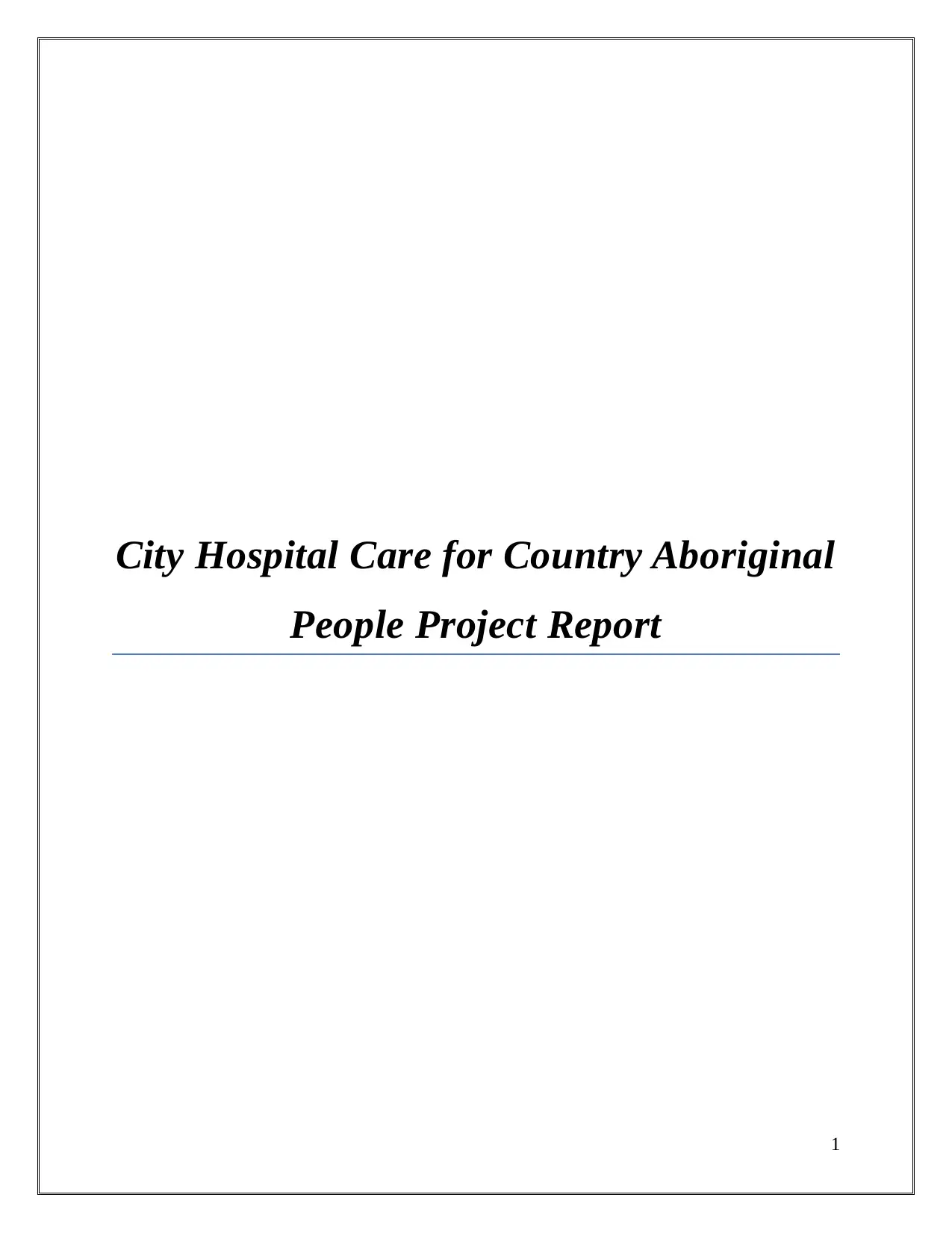
City Hospital Care for Country Aboriginal
People Project Report
1
People Project Report
1
Secure Best Marks with AI Grader
Need help grading? Try our AI Grader for instant feedback on your assignments.
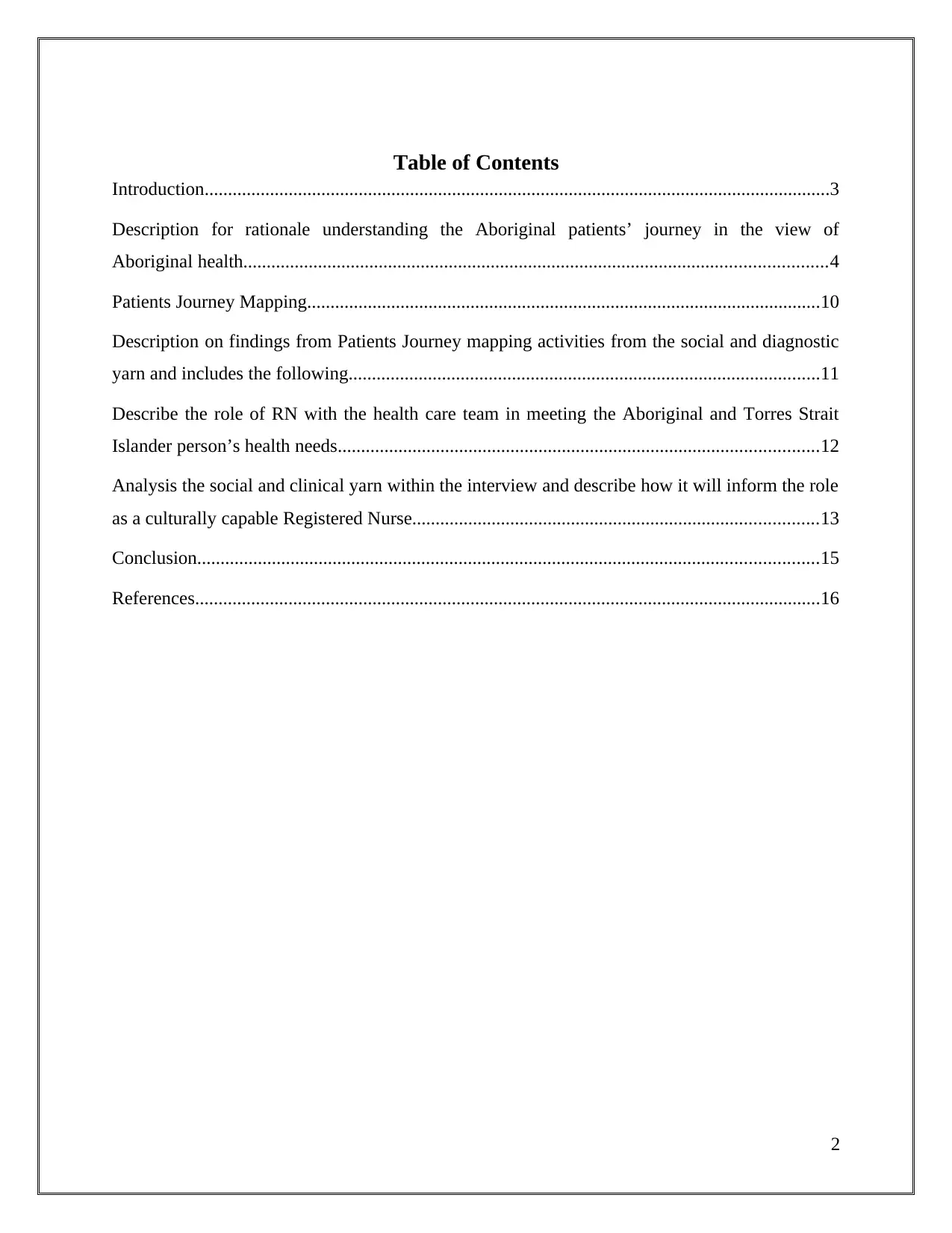
Table of Contents
Introduction......................................................................................................................................3
Description for rationale understanding the Aboriginal patients’ journey in the view of
Aboriginal health.............................................................................................................................4
Patients Journey Mapping..............................................................................................................10
Description on findings from Patients Journey mapping activities from the social and diagnostic
yarn and includes the following.....................................................................................................11
Describe the role of RN with the health care team in meeting the Aboriginal and Torres Strait
Islander person’s health needs.......................................................................................................12
Analysis the social and clinical yarn within the interview and describe how it will inform the role
as a culturally capable Registered Nurse.......................................................................................13
Conclusion.....................................................................................................................................15
References......................................................................................................................................16
2
Introduction......................................................................................................................................3
Description for rationale understanding the Aboriginal patients’ journey in the view of
Aboriginal health.............................................................................................................................4
Patients Journey Mapping..............................................................................................................10
Description on findings from Patients Journey mapping activities from the social and diagnostic
yarn and includes the following.....................................................................................................11
Describe the role of RN with the health care team in meeting the Aboriginal and Torres Strait
Islander person’s health needs.......................................................................................................12
Analysis the social and clinical yarn within the interview and describe how it will inform the role
as a culturally capable Registered Nurse.......................................................................................13
Conclusion.....................................................................................................................................15
References......................................................................................................................................16
2
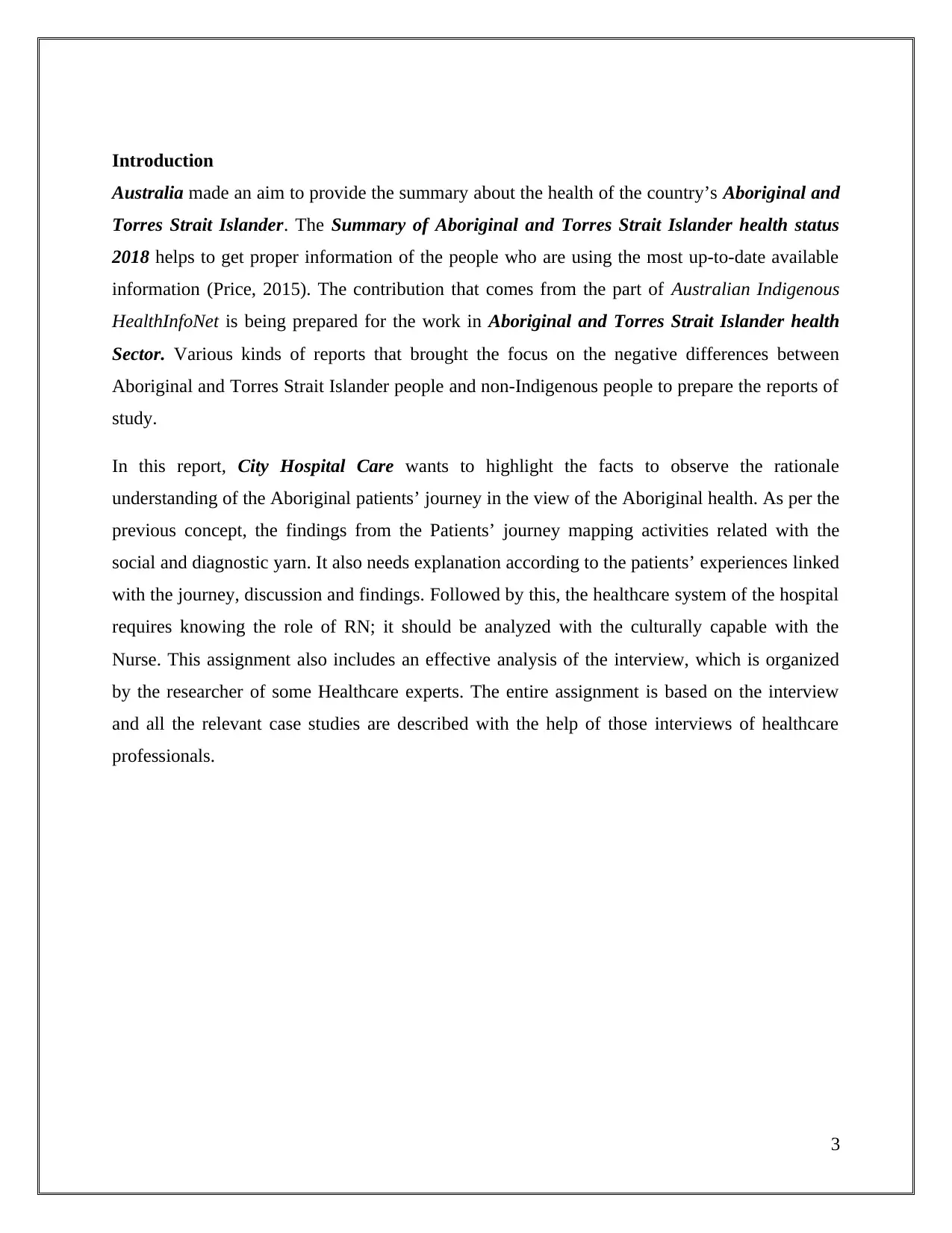
Introduction
Australia made an aim to provide the summary about the health of the country’s Aboriginal and
Torres Strait Islander. The Summary of Aboriginal and Torres Strait Islander health status
2018 helps to get proper information of the people who are using the most up-to-date available
information (Price, 2015). The contribution that comes from the part of Australian Indigenous
HealthInfoNet is being prepared for the work in Aboriginal and Torres Strait Islander health
Sector. Various kinds of reports that brought the focus on the negative differences between
Aboriginal and Torres Strait Islander people and non-Indigenous people to prepare the reports of
study.
In this report, City Hospital Care wants to highlight the facts to observe the rationale
understanding of the Aboriginal patients’ journey in the view of the Aboriginal health. As per the
previous concept, the findings from the Patients’ journey mapping activities related with the
social and diagnostic yarn. It also needs explanation according to the patients’ experiences linked
with the journey, discussion and findings. Followed by this, the healthcare system of the hospital
requires knowing the role of RN; it should be analyzed with the culturally capable with the
Nurse. This assignment also includes an effective analysis of the interview, which is organized
by the researcher of some Healthcare experts. The entire assignment is based on the interview
and all the relevant case studies are described with the help of those interviews of healthcare
professionals.
3
Australia made an aim to provide the summary about the health of the country’s Aboriginal and
Torres Strait Islander. The Summary of Aboriginal and Torres Strait Islander health status
2018 helps to get proper information of the people who are using the most up-to-date available
information (Price, 2015). The contribution that comes from the part of Australian Indigenous
HealthInfoNet is being prepared for the work in Aboriginal and Torres Strait Islander health
Sector. Various kinds of reports that brought the focus on the negative differences between
Aboriginal and Torres Strait Islander people and non-Indigenous people to prepare the reports of
study.
In this report, City Hospital Care wants to highlight the facts to observe the rationale
understanding of the Aboriginal patients’ journey in the view of the Aboriginal health. As per the
previous concept, the findings from the Patients’ journey mapping activities related with the
social and diagnostic yarn. It also needs explanation according to the patients’ experiences linked
with the journey, discussion and findings. Followed by this, the healthcare system of the hospital
requires knowing the role of RN; it should be analyzed with the culturally capable with the
Nurse. This assignment also includes an effective analysis of the interview, which is organized
by the researcher of some Healthcare experts. The entire assignment is based on the interview
and all the relevant case studies are described with the help of those interviews of healthcare
professionals.
3

Description for rationale understanding the Aboriginal patients’ journey in the view of
Aboriginal health
As per the observation, it is being estimated that there are near about 778,064 Aboriginal and
Torres Strait Islander people in Australia in the year 2018. As per the total population of the
country, the measurement has been done accordingly (Altman & Taylor, 2018). On the other
hand, majority of the people live in the city side, which is calculated as one-third of the
Aboriginal and Torres Strait Islander people in the year 2016.
Figure 1: Aboriginal and Torres Strait Islander Identification
(Source: Altman & Taylor, 2018)
As per the above figure highlighted the total Aboriginal and Torres Strait Islander identified
the population as Aboriginal is under the highest section of 91%, both the Aboriginal and
Torres Strait Islander is considered as 4% and the Torres Strait Islander is measured as 5%.
The age structure describes that it can grab every kind of population with different kinds of
reason, which are depending on the higher level of birth and death rates of the country.
4
Aboriginal health
As per the observation, it is being estimated that there are near about 778,064 Aboriginal and
Torres Strait Islander people in Australia in the year 2018. As per the total population of the
country, the measurement has been done accordingly (Altman & Taylor, 2018). On the other
hand, majority of the people live in the city side, which is calculated as one-third of the
Aboriginal and Torres Strait Islander people in the year 2016.
Figure 1: Aboriginal and Torres Strait Islander Identification
(Source: Altman & Taylor, 2018)
As per the above figure highlighted the total Aboriginal and Torres Strait Islander identified
the population as Aboriginal is under the highest section of 91%, both the Aboriginal and
Torres Strait Islander is considered as 4% and the Torres Strait Islander is measured as 5%.
The age structure describes that it can grab every kind of population with different kinds of
reason, which are depending on the higher level of birth and death rates of the country.
4
Secure Best Marks with AI Grader
Need help grading? Try our AI Grader for instant feedback on your assignments.
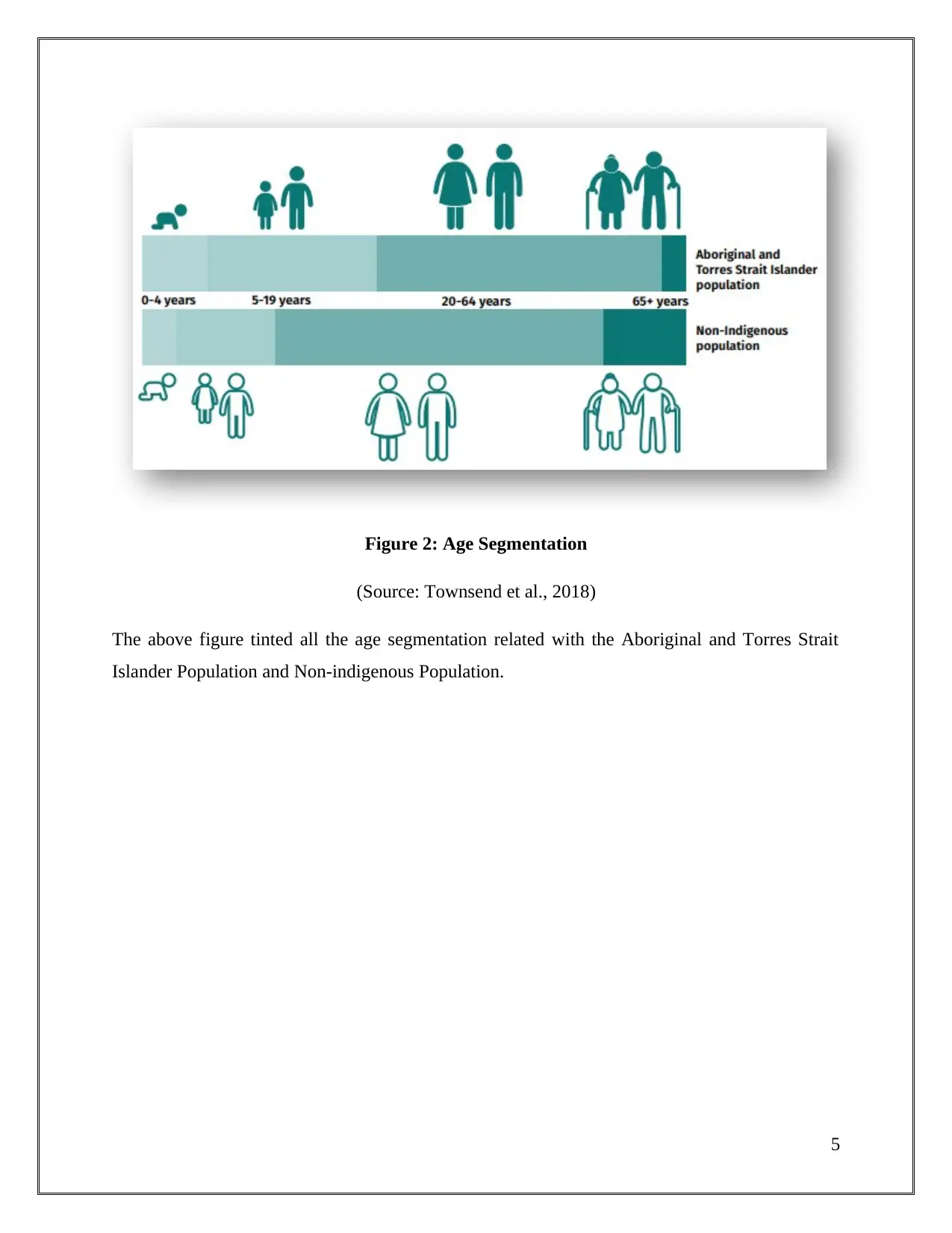
Figure 2: Age Segmentation
(Source: Townsend et al., 2018)
The above figure tinted all the age segmentation related with the Aboriginal and Torres Strait
Islander Population and Non-indigenous Population.
5
(Source: Townsend et al., 2018)
The above figure tinted all the age segmentation related with the Aboriginal and Torres Strait
Islander Population and Non-indigenous Population.
5
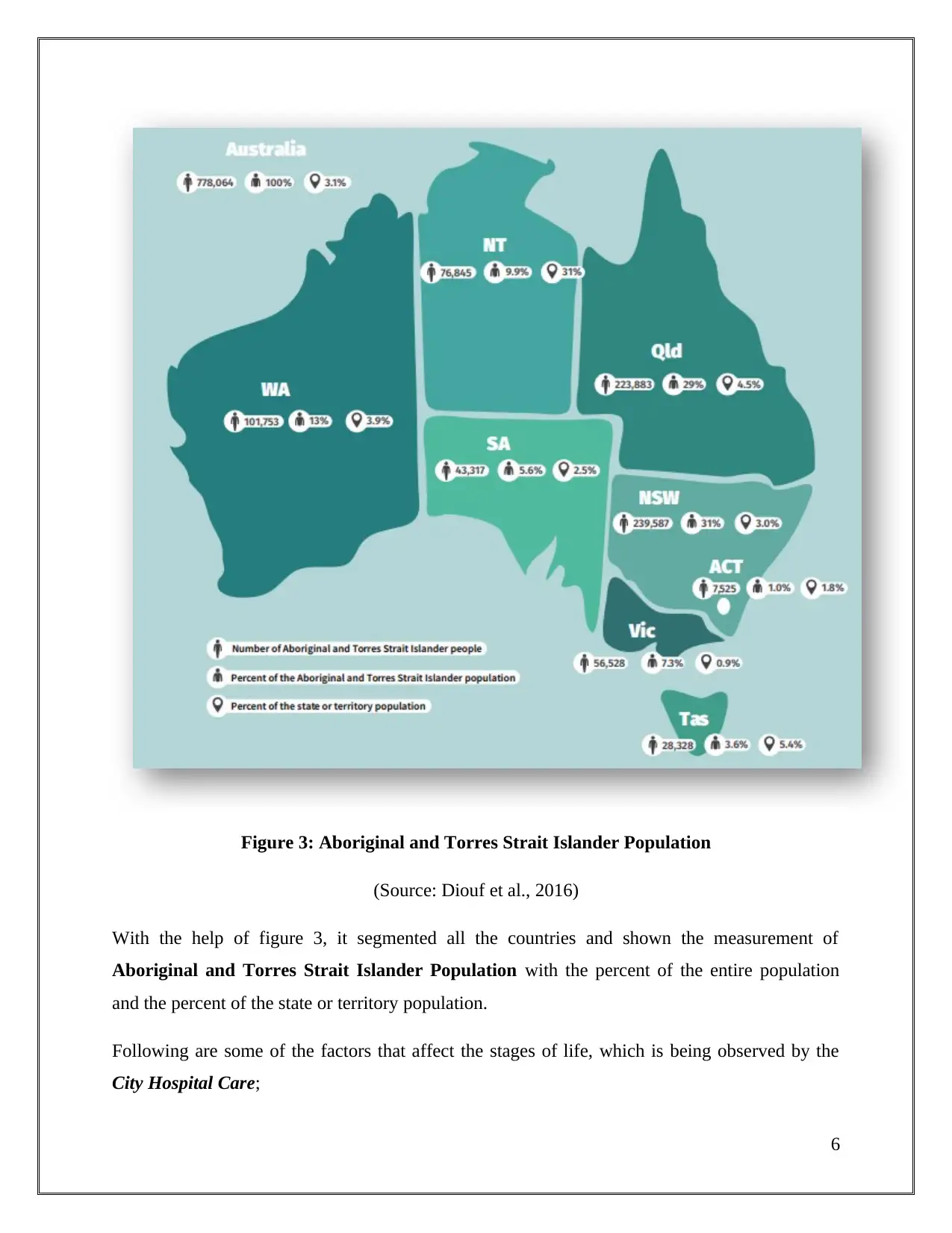
Figure 3: Aboriginal and Torres Strait Islander Population
(Source: Diouf et al., 2016)
With the help of figure 3, it segmented all the countries and shown the measurement of
Aboriginal and Torres Strait Islander Population with the percent of the entire population
and the percent of the state or territory population.
Following are some of the factors that affect the stages of life, which is being observed by the
City Hospital Care;
6
(Source: Diouf et al., 2016)
With the help of figure 3, it segmented all the countries and shown the measurement of
Aboriginal and Torres Strait Islander Population with the percent of the entire population
and the percent of the state or territory population.
Following are some of the factors that affect the stages of life, which is being observed by the
City Hospital Care;
6
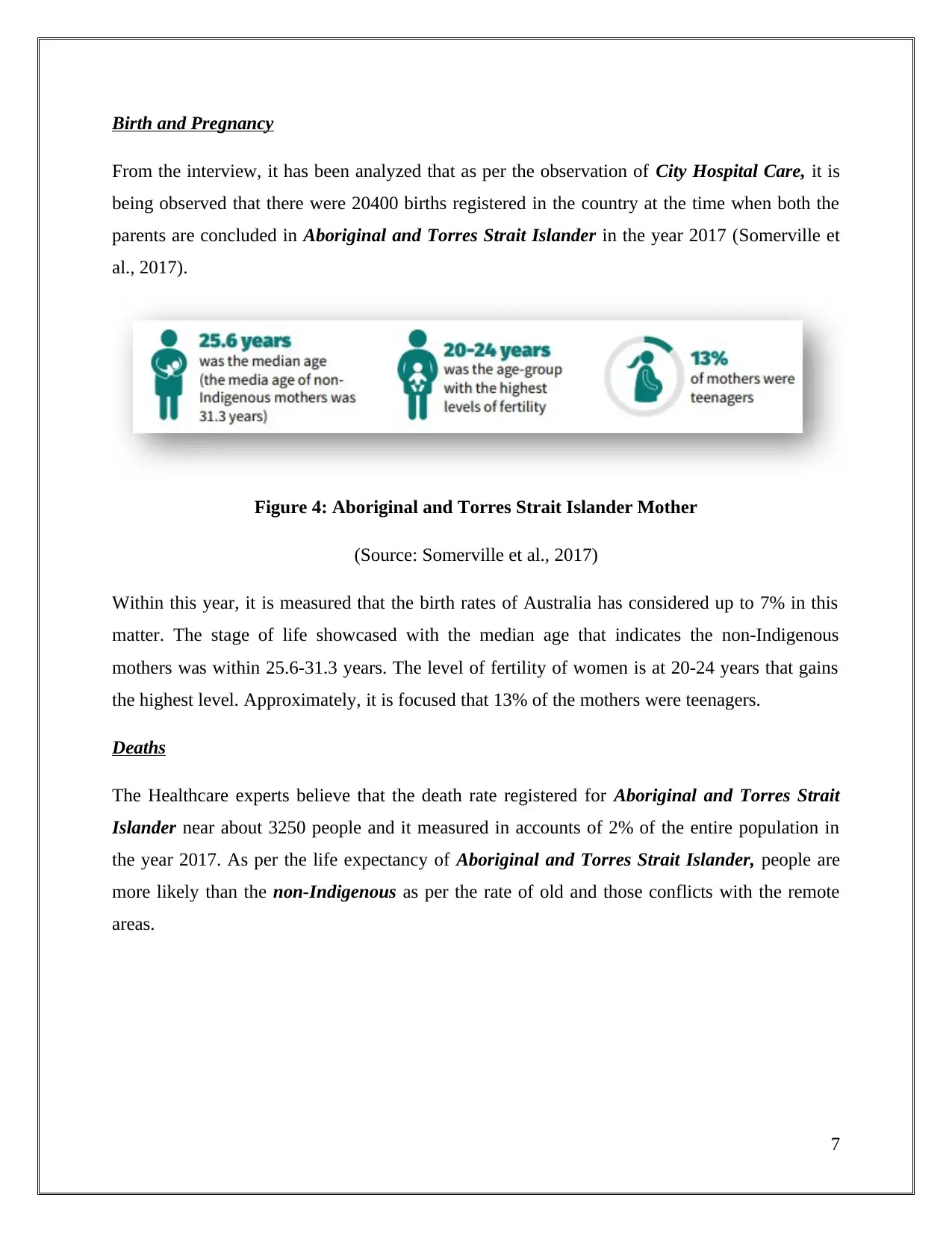
Birth and Pregnancy
From the interview, it has been analyzed that as per the observation of City Hospital Care, it is
being observed that there were 20400 births registered in the country at the time when both the
parents are concluded in Aboriginal and Torres Strait Islander in the year 2017 (Somerville et
al., 2017).
Figure 4: Aboriginal and Torres Strait Islander Mother
(Source: Somerville et al., 2017)
Within this year, it is measured that the birth rates of Australia has considered up to 7% in this
matter. The stage of life showcased with the median age that indicates the non-Indigenous
mothers was within 25.6-31.3 years. The level of fertility of women is at 20-24 years that gains
the highest level. Approximately, it is focused that 13% of the mothers were teenagers.
Deaths
The Healthcare experts believe that the death rate registered for Aboriginal and Torres Strait
Islander near about 3250 people and it measured in accounts of 2% of the entire population in
the year 2017. As per the life expectancy of Aboriginal and Torres Strait Islander, people are
more likely than the non-Indigenous as per the rate of old and those conflicts with the remote
areas.
7
From the interview, it has been analyzed that as per the observation of City Hospital Care, it is
being observed that there were 20400 births registered in the country at the time when both the
parents are concluded in Aboriginal and Torres Strait Islander in the year 2017 (Somerville et
al., 2017).
Figure 4: Aboriginal and Torres Strait Islander Mother
(Source: Somerville et al., 2017)
Within this year, it is measured that the birth rates of Australia has considered up to 7% in this
matter. The stage of life showcased with the median age that indicates the non-Indigenous
mothers was within 25.6-31.3 years. The level of fertility of women is at 20-24 years that gains
the highest level. Approximately, it is focused that 13% of the mothers were teenagers.
Deaths
The Healthcare experts believe that the death rate registered for Aboriginal and Torres Strait
Islander near about 3250 people and it measured in accounts of 2% of the entire population in
the year 2017. As per the life expectancy of Aboriginal and Torres Strait Islander, people are
more likely than the non-Indigenous as per the rate of old and those conflicts with the remote
areas.
7
Paraphrase This Document
Need a fresh take? Get an instant paraphrase of this document with our AI Paraphraser
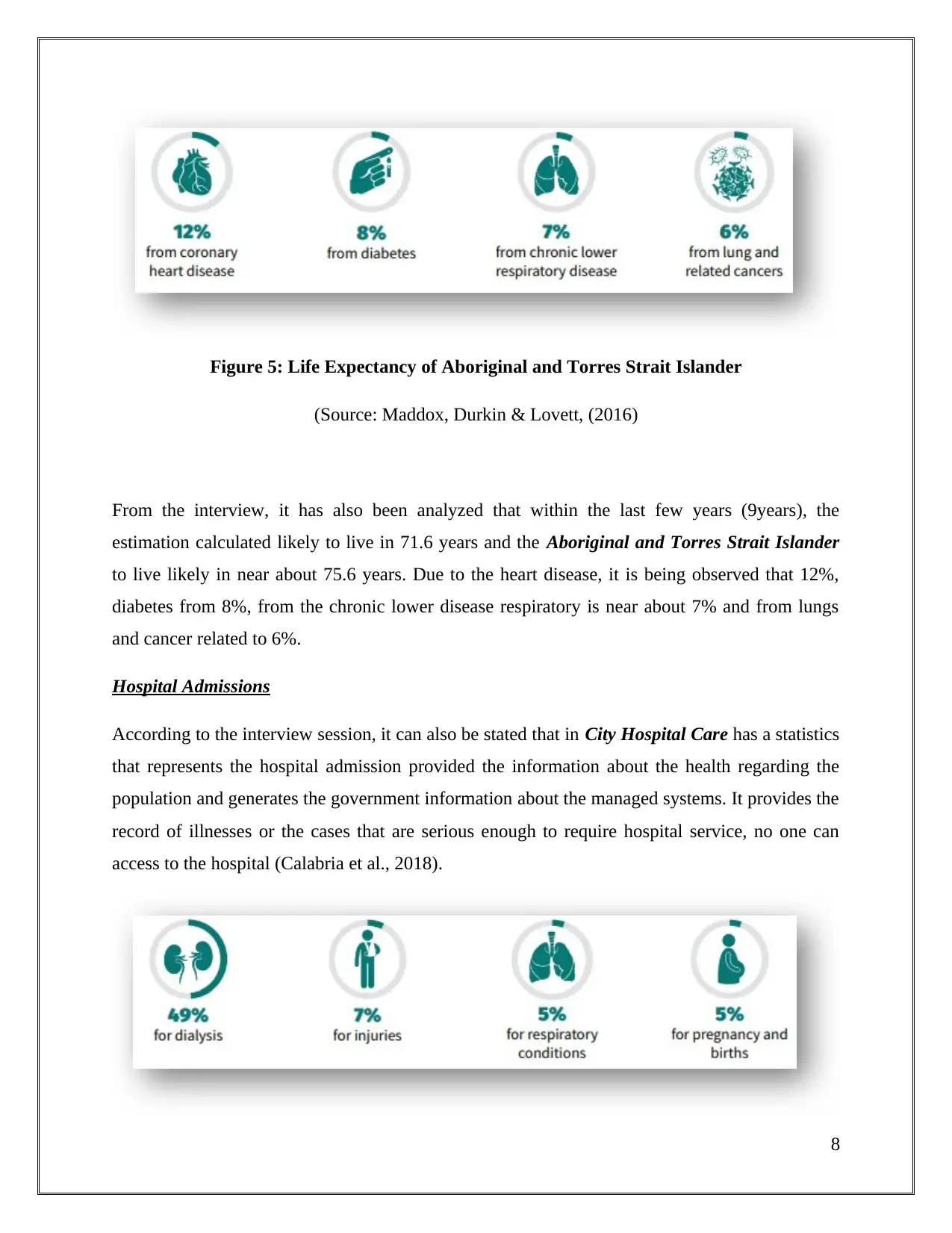
Figure 5: Life Expectancy of Aboriginal and Torres Strait Islander
(Source: Maddox, Durkin & Lovett, (2016)
From the interview, it has also been analyzed that within the last few years (9years), the
estimation calculated likely to live in 71.6 years and the Aboriginal and Torres Strait Islander
to live likely in near about 75.6 years. Due to the heart disease, it is being observed that 12%,
diabetes from 8%, from the chronic lower disease respiratory is near about 7% and from lungs
and cancer related to 6%.
Hospital Admissions
According to the interview session, it can also be stated that in City Hospital Care has a statistics
that represents the hospital admission provided the information about the health regarding the
population and generates the government information about the managed systems. It provides the
record of illnesses or the cases that are serious enough to require hospital service, no one can
access to the hospital (Calabria et al., 2018).
8
(Source: Maddox, Durkin & Lovett, (2016)
From the interview, it has also been analyzed that within the last few years (9years), the
estimation calculated likely to live in 71.6 years and the Aboriginal and Torres Strait Islander
to live likely in near about 75.6 years. Due to the heart disease, it is being observed that 12%,
diabetes from 8%, from the chronic lower disease respiratory is near about 7% and from lungs
and cancer related to 6%.
Hospital Admissions
According to the interview session, it can also be stated that in City Hospital Care has a statistics
that represents the hospital admission provided the information about the health regarding the
population and generates the government information about the managed systems. It provides the
record of illnesses or the cases that are serious enough to require hospital service, no one can
access to the hospital (Calabria et al., 2018).
8
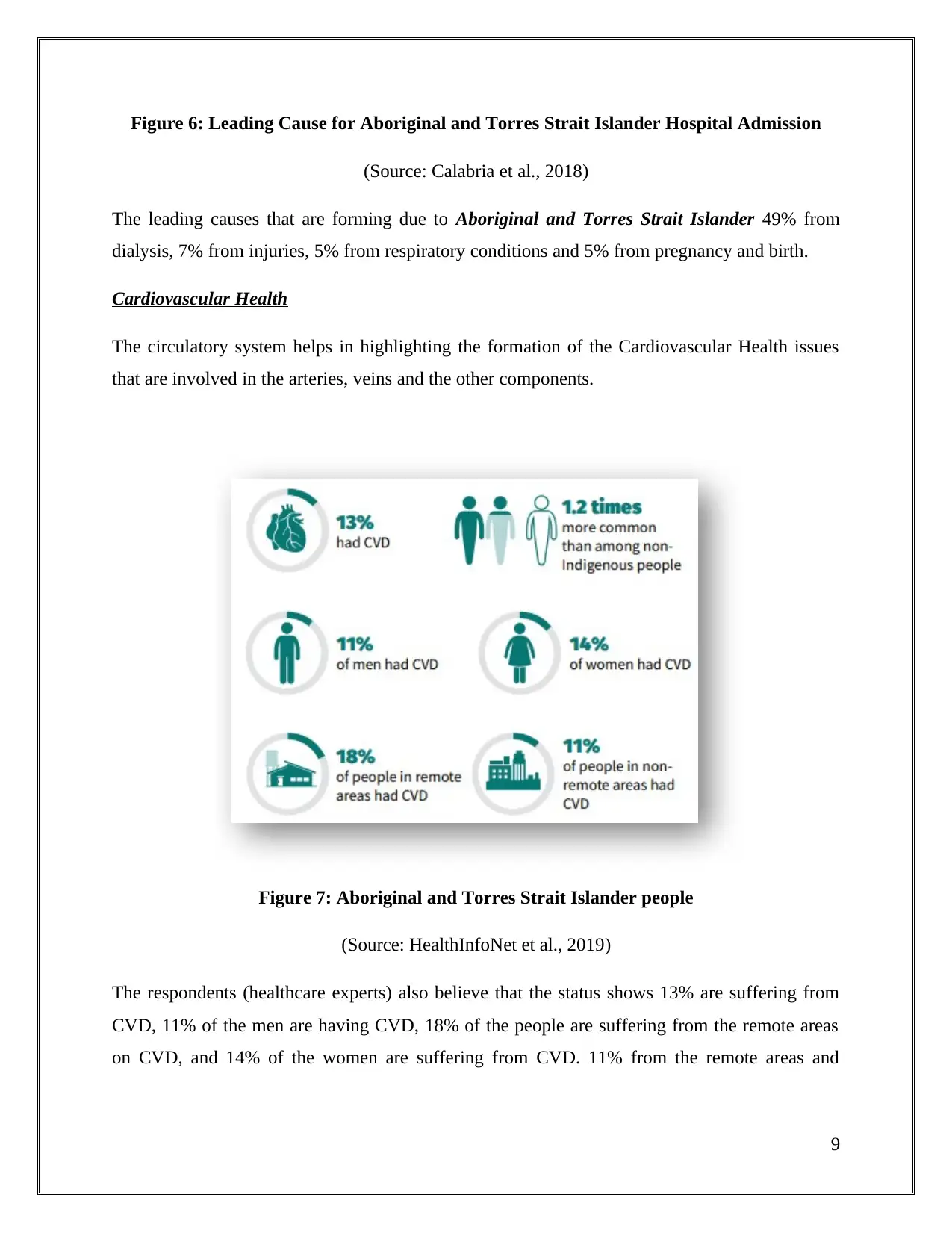
Figure 6: Leading Cause for Aboriginal and Torres Strait Islander Hospital Admission
(Source: Calabria et al., 2018)
The leading causes that are forming due to Aboriginal and Torres Strait Islander 49% from
dialysis, 7% from injuries, 5% from respiratory conditions and 5% from pregnancy and birth.
Cardiovascular Health
The circulatory system helps in highlighting the formation of the Cardiovascular Health issues
that are involved in the arteries, veins and the other components.
Figure 7: Aboriginal and Torres Strait Islander people
(Source: HealthInfoNet et al., 2019)
The respondents (healthcare experts) also believe that the status shows 13% are suffering from
CVD, 11% of the men are having CVD, 18% of the people are suffering from the remote areas
on CVD, and 14% of the women are suffering from CVD. 11% from the remote areas and
9
(Source: Calabria et al., 2018)
The leading causes that are forming due to Aboriginal and Torres Strait Islander 49% from
dialysis, 7% from injuries, 5% from respiratory conditions and 5% from pregnancy and birth.
Cardiovascular Health
The circulatory system helps in highlighting the formation of the Cardiovascular Health issues
that are involved in the arteries, veins and the other components.
Figure 7: Aboriginal and Torres Strait Islander people
(Source: HealthInfoNet et al., 2019)
The respondents (healthcare experts) also believe that the status shows 13% are suffering from
CVD, 11% of the men are having CVD, 18% of the people are suffering from the remote areas
on CVD, and 14% of the women are suffering from CVD. 11% from the remote areas and
9
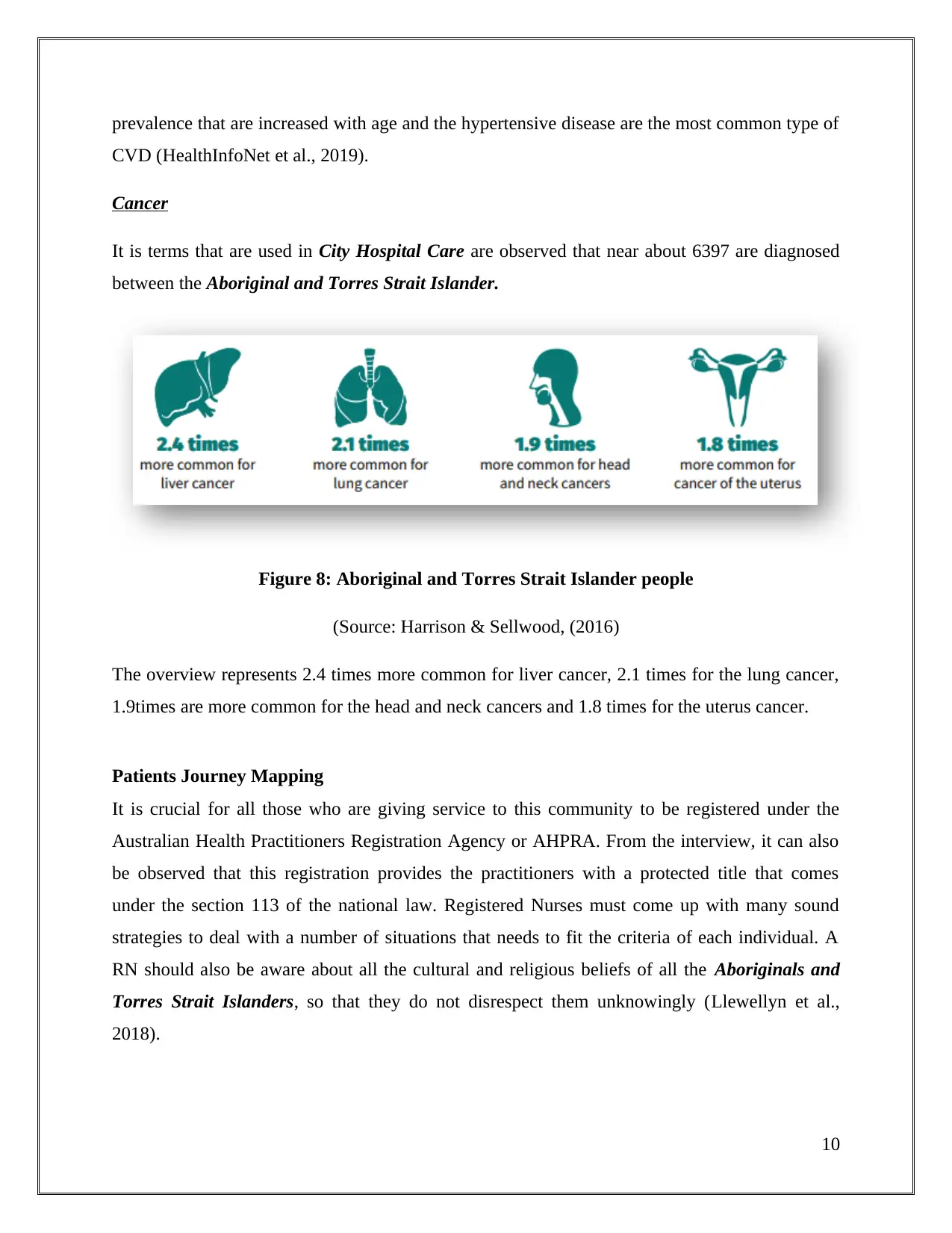
prevalence that are increased with age and the hypertensive disease are the most common type of
CVD (HealthInfoNet et al., 2019).
Cancer
It is terms that are used in City Hospital Care are observed that near about 6397 are diagnosed
between the Aboriginal and Torres Strait Islander.
Figure 8: Aboriginal and Torres Strait Islander people
(Source: Harrison & Sellwood, (2016)
The overview represents 2.4 times more common for liver cancer, 2.1 times for the lung cancer,
1.9times are more common for the head and neck cancers and 1.8 times for the uterus cancer.
Patients Journey Mapping
It is crucial for all those who are giving service to this community to be registered under the
Australian Health Practitioners Registration Agency or AHPRA. From the interview, it can also
be observed that this registration provides the practitioners with a protected title that comes
under the section 113 of the national law. Registered Nurses must come up with many sound
strategies to deal with a number of situations that needs to fit the criteria of each individual. A
RN should also be aware about all the cultural and religious beliefs of all the Aboriginals and
Torres Strait Islanders, so that they do not disrespect them unknowingly (Llewellyn et al.,
2018).
10
CVD (HealthInfoNet et al., 2019).
Cancer
It is terms that are used in City Hospital Care are observed that near about 6397 are diagnosed
between the Aboriginal and Torres Strait Islander.
Figure 8: Aboriginal and Torres Strait Islander people
(Source: Harrison & Sellwood, (2016)
The overview represents 2.4 times more common for liver cancer, 2.1 times for the lung cancer,
1.9times are more common for the head and neck cancers and 1.8 times for the uterus cancer.
Patients Journey Mapping
It is crucial for all those who are giving service to this community to be registered under the
Australian Health Practitioners Registration Agency or AHPRA. From the interview, it can also
be observed that this registration provides the practitioners with a protected title that comes
under the section 113 of the national law. Registered Nurses must come up with many sound
strategies to deal with a number of situations that needs to fit the criteria of each individual. A
RN should also be aware about all the cultural and religious beliefs of all the Aboriginals and
Torres Strait Islanders, so that they do not disrespect them unknowingly (Llewellyn et al.,
2018).
10
Secure Best Marks with AI Grader
Need help grading? Try our AI Grader for instant feedback on your assignments.
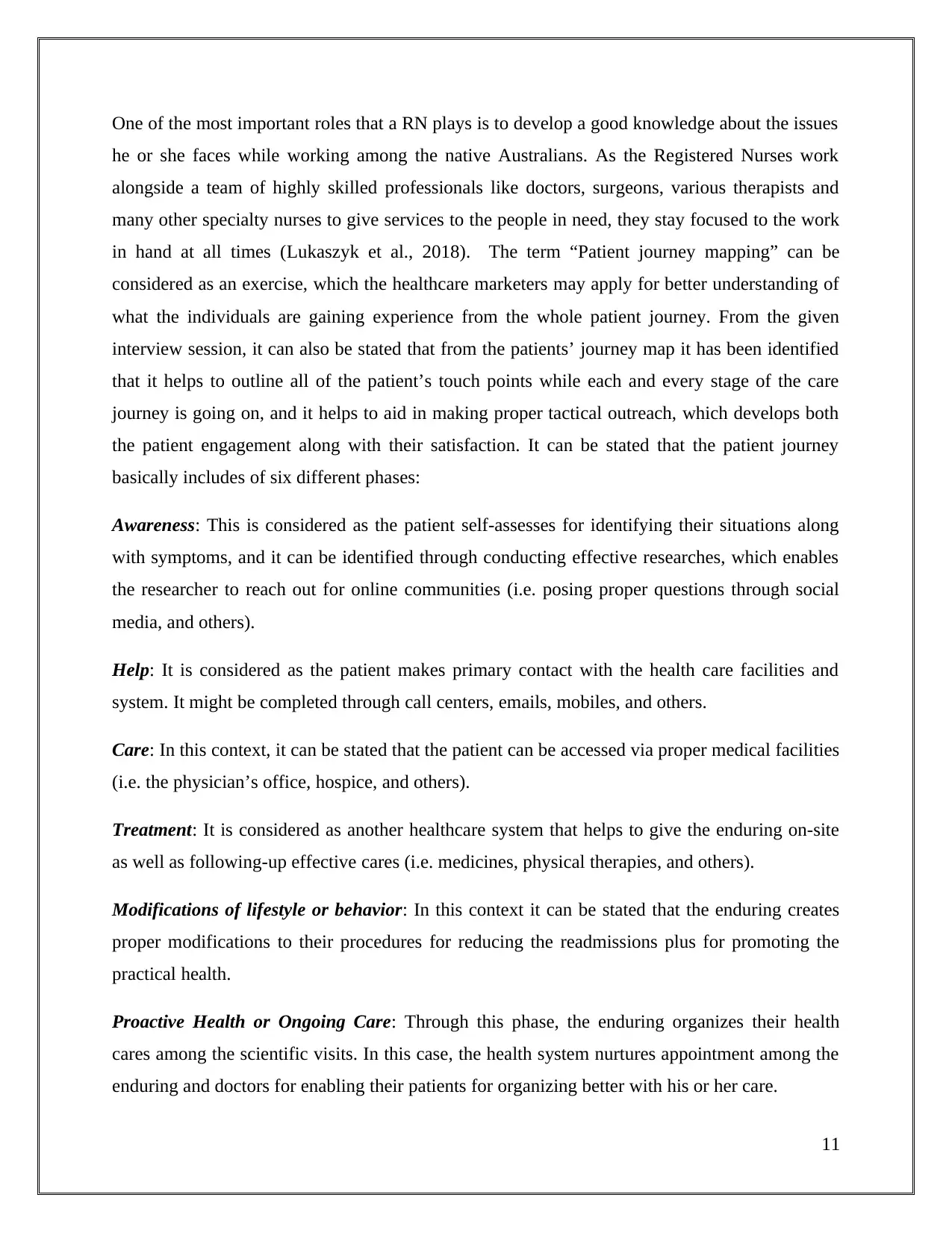
One of the most important roles that a RN plays is to develop a good knowledge about the issues
he or she faces while working among the native Australians. As the Registered Nurses work
alongside a team of highly skilled professionals like doctors, surgeons, various therapists and
many other specialty nurses to give services to the people in need, they stay focused to the work
in hand at all times (Lukaszyk et al., 2018). The term “Patient journey mapping” can be
considered as an exercise, which the healthcare marketers may apply for better understanding of
what the individuals are gaining experience from the whole patient journey. From the given
interview session, it can also be stated that from the patients’ journey map it has been identified
that it helps to outline all of the patient’s touch points while each and every stage of the care
journey is going on, and it helps to aid in making proper tactical outreach, which develops both
the patient engagement along with their satisfaction. It can be stated that the patient journey
basically includes of six different phases:
Awareness: This is considered as the patient self-assesses for identifying their situations along
with symptoms, and it can be identified through conducting effective researches, which enables
the researcher to reach out for online communities (i.e. posing proper questions through social
media, and others).
Help: It is considered as the patient makes primary contact with the health care facilities and
system. It might be completed through call centers, emails, mobiles, and others.
Care: In this context, it can be stated that the patient can be accessed via proper medical facilities
(i.e. the physician’s office, hospice, and others).
Treatment: It is considered as another healthcare system that helps to give the enduring on-site
as well as following-up effective cares (i.e. medicines, physical therapies, and others).
Modifications of lifestyle or behavior: In this context it can be stated that the enduring creates
proper modifications to their procedures for reducing the readmissions plus for promoting the
practical health.
Proactive Health or Ongoing Care: Through this phase, the enduring organizes their health
cares among the scientific visits. In this case, the health system nurtures appointment among the
enduring and doctors for enabling their patients for organizing better with his or her care.
11
he or she faces while working among the native Australians. As the Registered Nurses work
alongside a team of highly skilled professionals like doctors, surgeons, various therapists and
many other specialty nurses to give services to the people in need, they stay focused to the work
in hand at all times (Lukaszyk et al., 2018). The term “Patient journey mapping” can be
considered as an exercise, which the healthcare marketers may apply for better understanding of
what the individuals are gaining experience from the whole patient journey. From the given
interview session, it can also be stated that from the patients’ journey map it has been identified
that it helps to outline all of the patient’s touch points while each and every stage of the care
journey is going on, and it helps to aid in making proper tactical outreach, which develops both
the patient engagement along with their satisfaction. It can be stated that the patient journey
basically includes of six different phases:
Awareness: This is considered as the patient self-assesses for identifying their situations along
with symptoms, and it can be identified through conducting effective researches, which enables
the researcher to reach out for online communities (i.e. posing proper questions through social
media, and others).
Help: It is considered as the patient makes primary contact with the health care facilities and
system. It might be completed through call centers, emails, mobiles, and others.
Care: In this context, it can be stated that the patient can be accessed via proper medical facilities
(i.e. the physician’s office, hospice, and others).
Treatment: It is considered as another healthcare system that helps to give the enduring on-site
as well as following-up effective cares (i.e. medicines, physical therapies, and others).
Modifications of lifestyle or behavior: In this context it can be stated that the enduring creates
proper modifications to their procedures for reducing the readmissions plus for promoting the
practical health.
Proactive Health or Ongoing Care: Through this phase, the enduring organizes their health
cares among the scientific visits. In this case, the health system nurtures appointment among the
enduring and doctors for enabling their patients for organizing better with his or her care.
11
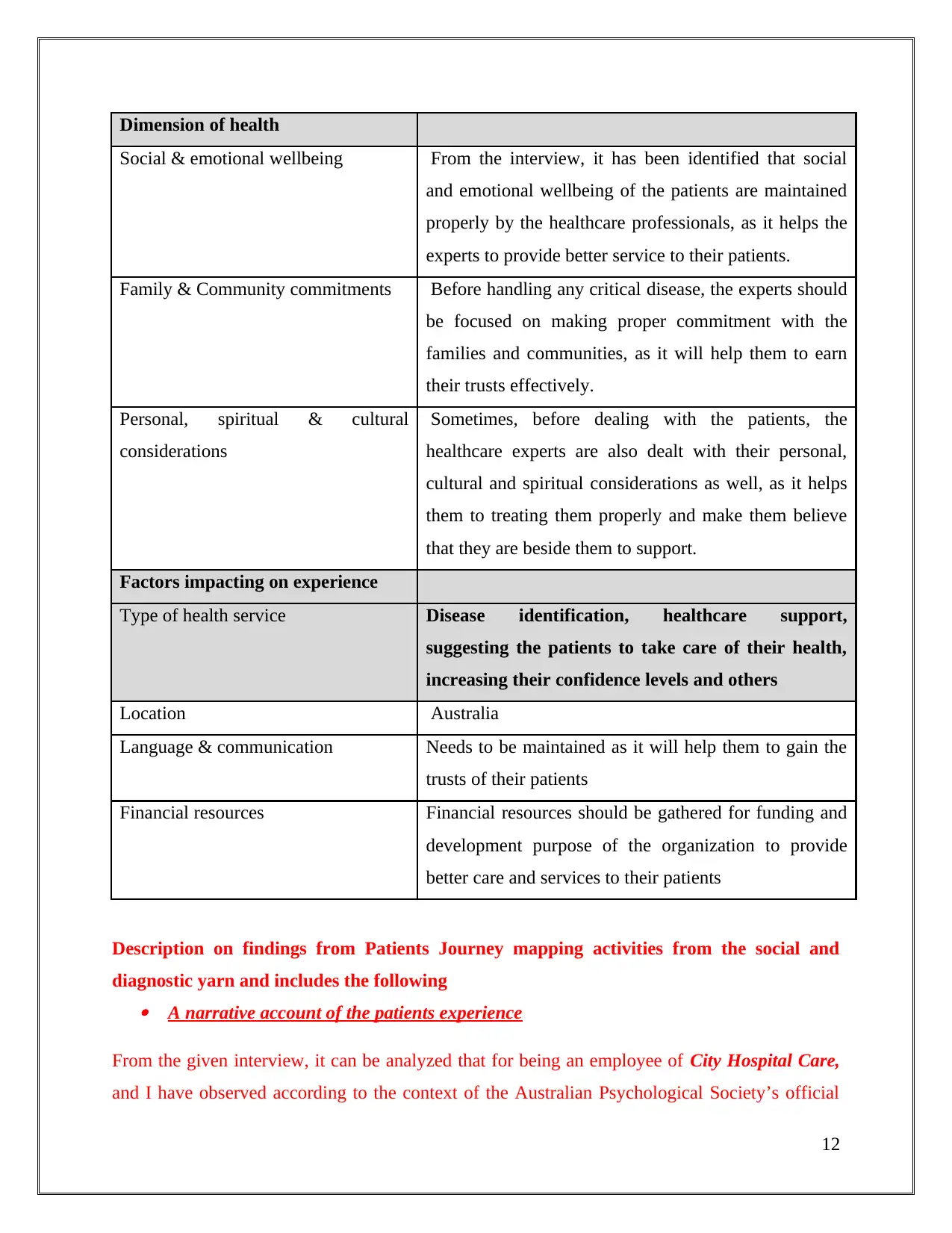
Dimension of health
Social & emotional wellbeing From the interview, it has been identified that social
and emotional wellbeing of the patients are maintained
properly by the healthcare professionals, as it helps the
experts to provide better service to their patients.
Family & Community commitments Before handling any critical disease, the experts should
be focused on making proper commitment with the
families and communities, as it will help them to earn
their trusts effectively.
Personal, spiritual & cultural
considerations
Sometimes, before dealing with the patients, the
healthcare experts are also dealt with their personal,
cultural and spiritual considerations as well, as it helps
them to treating them properly and make them believe
that they are beside them to support.
Factors impacting on experience
Type of health service Disease identification, healthcare support,
suggesting the patients to take care of their health,
increasing their confidence levels and others
Location Australia
Language & communication Needs to be maintained as it will help them to gain the
trusts of their patients
Financial resources Financial resources should be gathered for funding and
development purpose of the organization to provide
better care and services to their patients
Description on findings from Patients Journey mapping activities from the social and
diagnostic yarn and includes the following A narrative account of the patients experience
From the given interview, it can be analyzed that for being an employee of City Hospital Care,
and I have observed according to the context of the Australian Psychological Society’s official
12
Social & emotional wellbeing From the interview, it has been identified that social
and emotional wellbeing of the patients are maintained
properly by the healthcare professionals, as it helps the
experts to provide better service to their patients.
Family & Community commitments Before handling any critical disease, the experts should
be focused on making proper commitment with the
families and communities, as it will help them to earn
their trusts effectively.
Personal, spiritual & cultural
considerations
Sometimes, before dealing with the patients, the
healthcare experts are also dealt with their personal,
cultural and spiritual considerations as well, as it helps
them to treating them properly and make them believe
that they are beside them to support.
Factors impacting on experience
Type of health service Disease identification, healthcare support,
suggesting the patients to take care of their health,
increasing their confidence levels and others
Location Australia
Language & communication Needs to be maintained as it will help them to gain the
trusts of their patients
Financial resources Financial resources should be gathered for funding and
development purpose of the organization to provide
better care and services to their patients
Description on findings from Patients Journey mapping activities from the social and
diagnostic yarn and includes the following A narrative account of the patients experience
From the given interview, it can be analyzed that for being an employee of City Hospital Care,
and I have observed according to the context of the Australian Psychological Society’s official
12
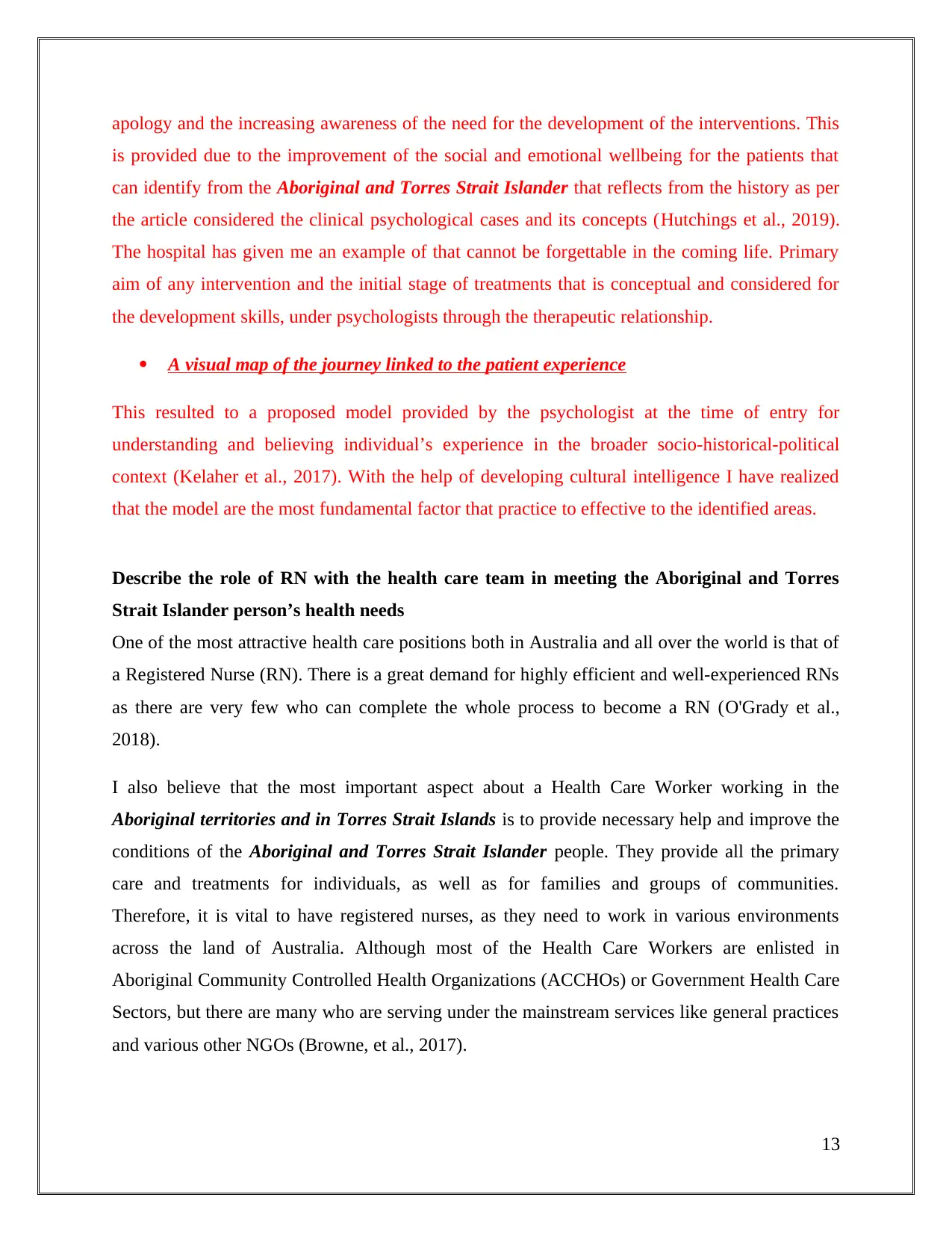
apology and the increasing awareness of the need for the development of the interventions. This
is provided due to the improvement of the social and emotional wellbeing for the patients that
can identify from the Aboriginal and Torres Strait Islander that reflects from the history as per
the article considered the clinical psychological cases and its concepts (Hutchings et al., 2019).
The hospital has given me an example of that cannot be forgettable in the coming life. Primary
aim of any intervention and the initial stage of treatments that is conceptual and considered for
the development skills, under psychologists through the therapeutic relationship.
A visual map of the journey linked to the patient experience
This resulted to a proposed model provided by the psychologist at the time of entry for
understanding and believing individual’s experience in the broader socio-historical-political
context (Kelaher et al., 2017). With the help of developing cultural intelligence I have realized
that the model are the most fundamental factor that practice to effective to the identified areas.
Describe the role of RN with the health care team in meeting the Aboriginal and Torres
Strait Islander person’s health needs
One of the most attractive health care positions both in Australia and all over the world is that of
a Registered Nurse (RN). There is a great demand for highly efficient and well-experienced RNs
as there are very few who can complete the whole process to become a RN (O'Grady et al.,
2018).
I also believe that the most important aspect about a Health Care Worker working in the
Aboriginal territories and in Torres Strait Islands is to provide necessary help and improve the
conditions of the Aboriginal and Torres Strait Islander people. They provide all the primary
care and treatments for individuals, as well as for families and groups of communities.
Therefore, it is vital to have registered nurses, as they need to work in various environments
across the land of Australia. Although most of the Health Care Workers are enlisted in
Aboriginal Community Controlled Health Organizations (ACCHOs) or Government Health Care
Sectors, but there are many who are serving under the mainstream services like general practices
and various other NGOs (Browne, et al., 2017).
13
is provided due to the improvement of the social and emotional wellbeing for the patients that
can identify from the Aboriginal and Torres Strait Islander that reflects from the history as per
the article considered the clinical psychological cases and its concepts (Hutchings et al., 2019).
The hospital has given me an example of that cannot be forgettable in the coming life. Primary
aim of any intervention and the initial stage of treatments that is conceptual and considered for
the development skills, under psychologists through the therapeutic relationship.
A visual map of the journey linked to the patient experience
This resulted to a proposed model provided by the psychologist at the time of entry for
understanding and believing individual’s experience in the broader socio-historical-political
context (Kelaher et al., 2017). With the help of developing cultural intelligence I have realized
that the model are the most fundamental factor that practice to effective to the identified areas.
Describe the role of RN with the health care team in meeting the Aboriginal and Torres
Strait Islander person’s health needs
One of the most attractive health care positions both in Australia and all over the world is that of
a Registered Nurse (RN). There is a great demand for highly efficient and well-experienced RNs
as there are very few who can complete the whole process to become a RN (O'Grady et al.,
2018).
I also believe that the most important aspect about a Health Care Worker working in the
Aboriginal territories and in Torres Strait Islands is to provide necessary help and improve the
conditions of the Aboriginal and Torres Strait Islander people. They provide all the primary
care and treatments for individuals, as well as for families and groups of communities.
Therefore, it is vital to have registered nurses, as they need to work in various environments
across the land of Australia. Although most of the Health Care Workers are enlisted in
Aboriginal Community Controlled Health Organizations (ACCHOs) or Government Health Care
Sectors, but there are many who are serving under the mainstream services like general practices
and various other NGOs (Browne, et al., 2017).
13
Paraphrase This Document
Need a fresh take? Get an instant paraphrase of this document with our AI Paraphraser
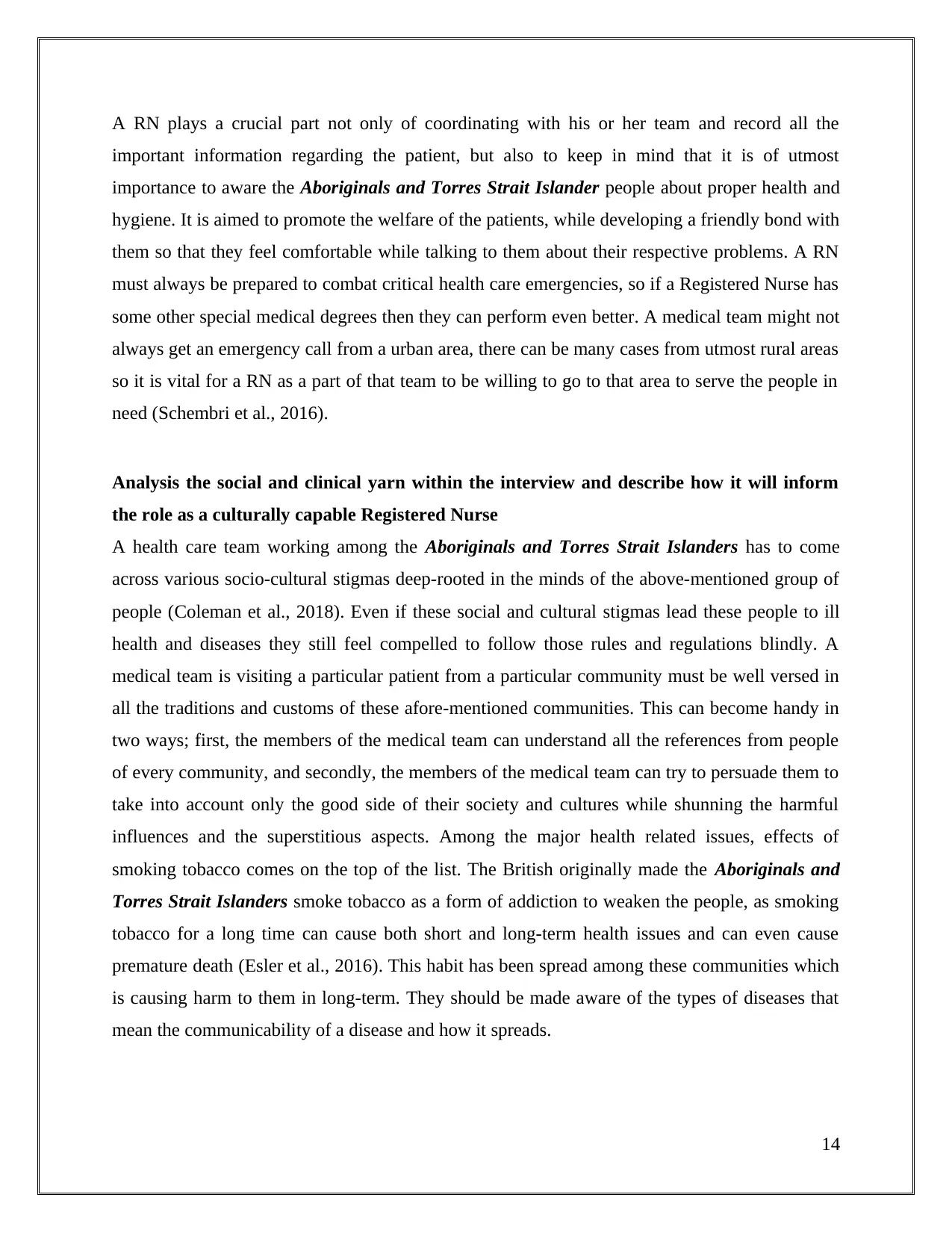
A RN plays a crucial part not only of coordinating with his or her team and record all the
important information regarding the patient, but also to keep in mind that it is of utmost
importance to aware the Aboriginals and Torres Strait Islander people about proper health and
hygiene. It is aimed to promote the welfare of the patients, while developing a friendly bond with
them so that they feel comfortable while talking to them about their respective problems. A RN
must always be prepared to combat critical health care emergencies, so if a Registered Nurse has
some other special medical degrees then they can perform even better. A medical team might not
always get an emergency call from a urban area, there can be many cases from utmost rural areas
so it is vital for a RN as a part of that team to be willing to go to that area to serve the people in
need (Schembri et al., 2016).
Analysis the social and clinical yarn within the interview and describe how it will inform
the role as a culturally capable Registered Nurse
A health care team working among the Aboriginals and Torres Strait Islanders has to come
across various socio-cultural stigmas deep-rooted in the minds of the above-mentioned group of
people (Coleman et al., 2018). Even if these social and cultural stigmas lead these people to ill
health and diseases they still feel compelled to follow those rules and regulations blindly. A
medical team is visiting a particular patient from a particular community must be well versed in
all the traditions and customs of these afore-mentioned communities. This can become handy in
two ways; first, the members of the medical team can understand all the references from people
of every community, and secondly, the members of the medical team can try to persuade them to
take into account only the good side of their society and cultures while shunning the harmful
influences and the superstitious aspects. Among the major health related issues, effects of
smoking tobacco comes on the top of the list. The British originally made the Aboriginals and
Torres Strait Islanders smoke tobacco as a form of addiction to weaken the people, as smoking
tobacco for a long time can cause both short and long-term health issues and can even cause
premature death (Esler et al., 2016). This habit has been spread among these communities which
is causing harm to them in long-term. They should be made aware of the types of diseases that
mean the communicability of a disease and how it spreads.
14
important information regarding the patient, but also to keep in mind that it is of utmost
importance to aware the Aboriginals and Torres Strait Islander people about proper health and
hygiene. It is aimed to promote the welfare of the patients, while developing a friendly bond with
them so that they feel comfortable while talking to them about their respective problems. A RN
must always be prepared to combat critical health care emergencies, so if a Registered Nurse has
some other special medical degrees then they can perform even better. A medical team might not
always get an emergency call from a urban area, there can be many cases from utmost rural areas
so it is vital for a RN as a part of that team to be willing to go to that area to serve the people in
need (Schembri et al., 2016).
Analysis the social and clinical yarn within the interview and describe how it will inform
the role as a culturally capable Registered Nurse
A health care team working among the Aboriginals and Torres Strait Islanders has to come
across various socio-cultural stigmas deep-rooted in the minds of the above-mentioned group of
people (Coleman et al., 2018). Even if these social and cultural stigmas lead these people to ill
health and diseases they still feel compelled to follow those rules and regulations blindly. A
medical team is visiting a particular patient from a particular community must be well versed in
all the traditions and customs of these afore-mentioned communities. This can become handy in
two ways; first, the members of the medical team can understand all the references from people
of every community, and secondly, the members of the medical team can try to persuade them to
take into account only the good side of their society and cultures while shunning the harmful
influences and the superstitious aspects. Among the major health related issues, effects of
smoking tobacco comes on the top of the list. The British originally made the Aboriginals and
Torres Strait Islanders smoke tobacco as a form of addiction to weaken the people, as smoking
tobacco for a long time can cause both short and long-term health issues and can even cause
premature death (Esler et al., 2016). This habit has been spread among these communities which
is causing harm to them in long-term. They should be made aware of the types of diseases that
mean the communicability of a disease and how it spreads.
14
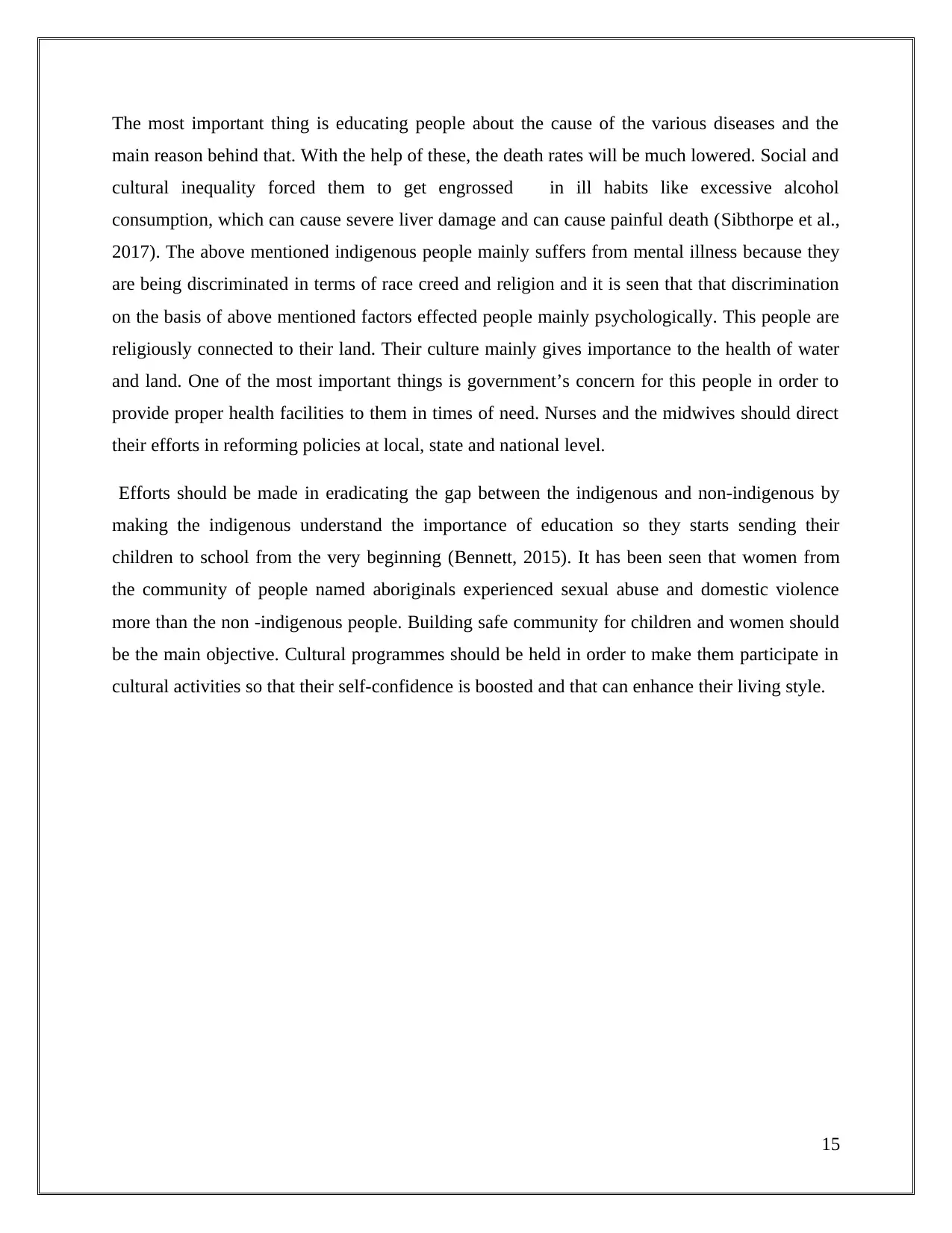
The most important thing is educating people about the cause of the various diseases and the
main reason behind that. With the help of these, the death rates will be much lowered. Social and
cultural inequality forced them to get engrossed in ill habits like excessive alcohol
consumption, which can cause severe liver damage and can cause painful death (Sibthorpe et al.,
2017). The above mentioned indigenous people mainly suffers from mental illness because they
are being discriminated in terms of race creed and religion and it is seen that that discrimination
on the basis of above mentioned factors effected people mainly psychologically. This people are
religiously connected to their land. Their culture mainly gives importance to the health of water
and land. One of the most important things is government’s concern for this people in order to
provide proper health facilities to them in times of need. Nurses and the midwives should direct
their efforts in reforming policies at local, state and national level.
Efforts should be made in eradicating the gap between the indigenous and non-indigenous by
making the indigenous understand the importance of education so they starts sending their
children to school from the very beginning (Bennett, 2015). It has been seen that women from
the community of people named aboriginals experienced sexual abuse and domestic violence
more than the non -indigenous people. Building safe community for children and women should
be the main objective. Cultural programmes should be held in order to make them participate in
cultural activities so that their self-confidence is boosted and that can enhance their living style.
15
main reason behind that. With the help of these, the death rates will be much lowered. Social and
cultural inequality forced them to get engrossed in ill habits like excessive alcohol
consumption, which can cause severe liver damage and can cause painful death (Sibthorpe et al.,
2017). The above mentioned indigenous people mainly suffers from mental illness because they
are being discriminated in terms of race creed and religion and it is seen that that discrimination
on the basis of above mentioned factors effected people mainly psychologically. This people are
religiously connected to their land. Their culture mainly gives importance to the health of water
and land. One of the most important things is government’s concern for this people in order to
provide proper health facilities to them in times of need. Nurses and the midwives should direct
their efforts in reforming policies at local, state and national level.
Efforts should be made in eradicating the gap between the indigenous and non-indigenous by
making the indigenous understand the importance of education so they starts sending their
children to school from the very beginning (Bennett, 2015). It has been seen that women from
the community of people named aboriginals experienced sexual abuse and domestic violence
more than the non -indigenous people. Building safe community for children and women should
be the main objective. Cultural programmes should be held in order to make them participate in
cultural activities so that their self-confidence is boosted and that can enhance their living style.
15
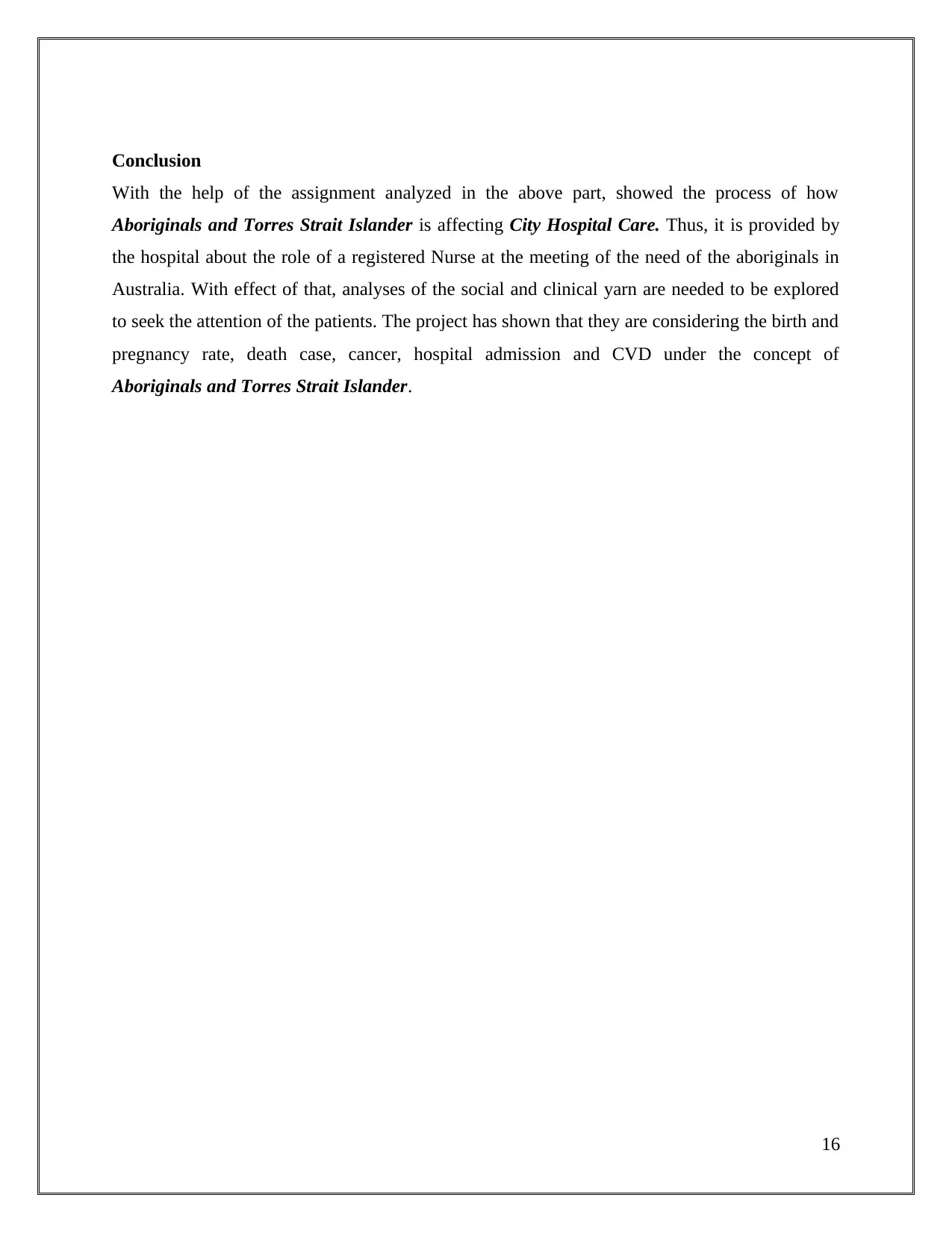
Conclusion
With the help of the assignment analyzed in the above part, showed the process of how
Aboriginals and Torres Strait Islander is affecting City Hospital Care. Thus, it is provided by
the hospital about the role of a registered Nurse at the meeting of the need of the aboriginals in
Australia. With effect of that, analyses of the social and clinical yarn are needed to be explored
to seek the attention of the patients. The project has shown that they are considering the birth and
pregnancy rate, death case, cancer, hospital admission and CVD under the concept of
Aboriginals and Torres Strait Islander.
16
With the help of the assignment analyzed in the above part, showed the process of how
Aboriginals and Torres Strait Islander is affecting City Hospital Care. Thus, it is provided by
the hospital about the role of a registered Nurse at the meeting of the need of the aboriginals in
Australia. With effect of that, analyses of the social and clinical yarn are needed to be explored
to seek the attention of the patients. The project has shown that they are considering the birth and
pregnancy rate, death case, cancer, hospital admission and CVD under the concept of
Aboriginals and Torres Strait Islander.
16
Secure Best Marks with AI Grader
Need help grading? Try our AI Grader for instant feedback on your assignments.
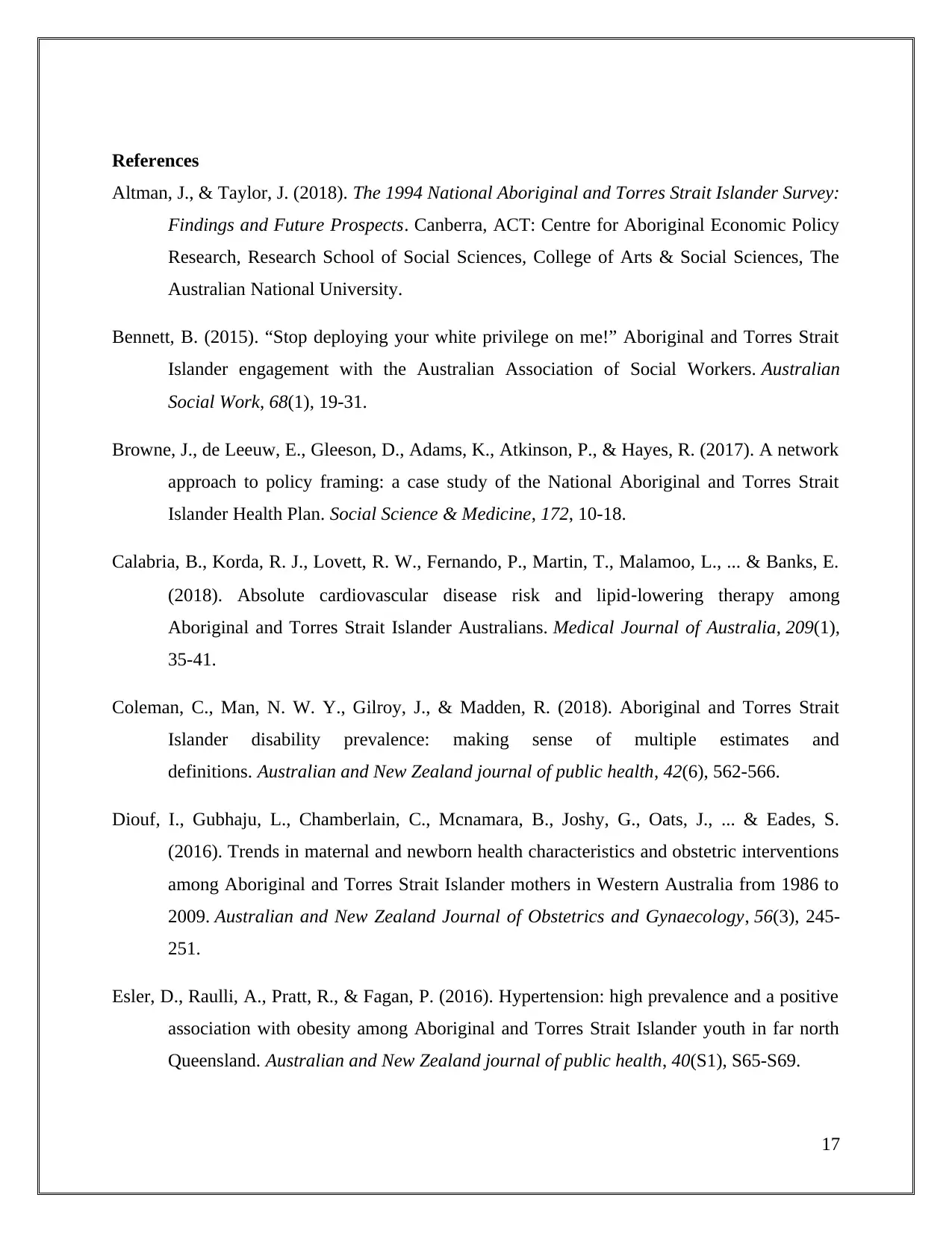
References
Altman, J., & Taylor, J. (2018). The 1994 National Aboriginal and Torres Strait Islander Survey:
Findings and Future Prospects. Canberra, ACT: Centre for Aboriginal Economic Policy
Research, Research School of Social Sciences, College of Arts & Social Sciences, The
Australian National University.
Bennett, B. (2015). “Stop deploying your white privilege on me!” Aboriginal and Torres Strait
Islander engagement with the Australian Association of Social Workers. Australian
Social Work, 68(1), 19-31.
Browne, J., de Leeuw, E., Gleeson, D., Adams, K., Atkinson, P., & Hayes, R. (2017). A network
approach to policy framing: a case study of the National Aboriginal and Torres Strait
Islander Health Plan. Social Science & Medicine, 172, 10-18.
Calabria, B., Korda, R. J., Lovett, R. W., Fernando, P., Martin, T., Malamoo, L., ... & Banks, E.
(2018). Absolute cardiovascular disease risk and lipid‐lowering therapy among
Aboriginal and Torres Strait Islander Australians. Medical Journal of Australia, 209(1),
35-41.
Coleman, C., Man, N. W. Y., Gilroy, J., & Madden, R. (2018). Aboriginal and Torres Strait
Islander disability prevalence: making sense of multiple estimates and
definitions. Australian and New Zealand journal of public health, 42(6), 562-566.
Diouf, I., Gubhaju, L., Chamberlain, C., Mcnamara, B., Joshy, G., Oats, J., ... & Eades, S.
(2016). Trends in maternal and newborn health characteristics and obstetric interventions
among Aboriginal and Torres Strait Islander mothers in Western Australia from 1986 to
2009. Australian and New Zealand Journal of Obstetrics and Gynaecology, 56(3), 245-
251.
Esler, D., Raulli, A., Pratt, R., & Fagan, P. (2016). Hypertension: high prevalence and a positive
association with obesity among Aboriginal and Torres Strait Islander youth in far north
Queensland. Australian and New Zealand journal of public health, 40(S1), S65-S69.
17
Altman, J., & Taylor, J. (2018). The 1994 National Aboriginal and Torres Strait Islander Survey:
Findings and Future Prospects. Canberra, ACT: Centre for Aboriginal Economic Policy
Research, Research School of Social Sciences, College of Arts & Social Sciences, The
Australian National University.
Bennett, B. (2015). “Stop deploying your white privilege on me!” Aboriginal and Torres Strait
Islander engagement with the Australian Association of Social Workers. Australian
Social Work, 68(1), 19-31.
Browne, J., de Leeuw, E., Gleeson, D., Adams, K., Atkinson, P., & Hayes, R. (2017). A network
approach to policy framing: a case study of the National Aboriginal and Torres Strait
Islander Health Plan. Social Science & Medicine, 172, 10-18.
Calabria, B., Korda, R. J., Lovett, R. W., Fernando, P., Martin, T., Malamoo, L., ... & Banks, E.
(2018). Absolute cardiovascular disease risk and lipid‐lowering therapy among
Aboriginal and Torres Strait Islander Australians. Medical Journal of Australia, 209(1),
35-41.
Coleman, C., Man, N. W. Y., Gilroy, J., & Madden, R. (2018). Aboriginal and Torres Strait
Islander disability prevalence: making sense of multiple estimates and
definitions. Australian and New Zealand journal of public health, 42(6), 562-566.
Diouf, I., Gubhaju, L., Chamberlain, C., Mcnamara, B., Joshy, G., Oats, J., ... & Eades, S.
(2016). Trends in maternal and newborn health characteristics and obstetric interventions
among Aboriginal and Torres Strait Islander mothers in Western Australia from 1986 to
2009. Australian and New Zealand Journal of Obstetrics and Gynaecology, 56(3), 245-
251.
Esler, D., Raulli, A., Pratt, R., & Fagan, P. (2016). Hypertension: high prevalence and a positive
association with obesity among Aboriginal and Torres Strait Islander youth in far north
Queensland. Australian and New Zealand journal of public health, 40(S1), S65-S69.
17
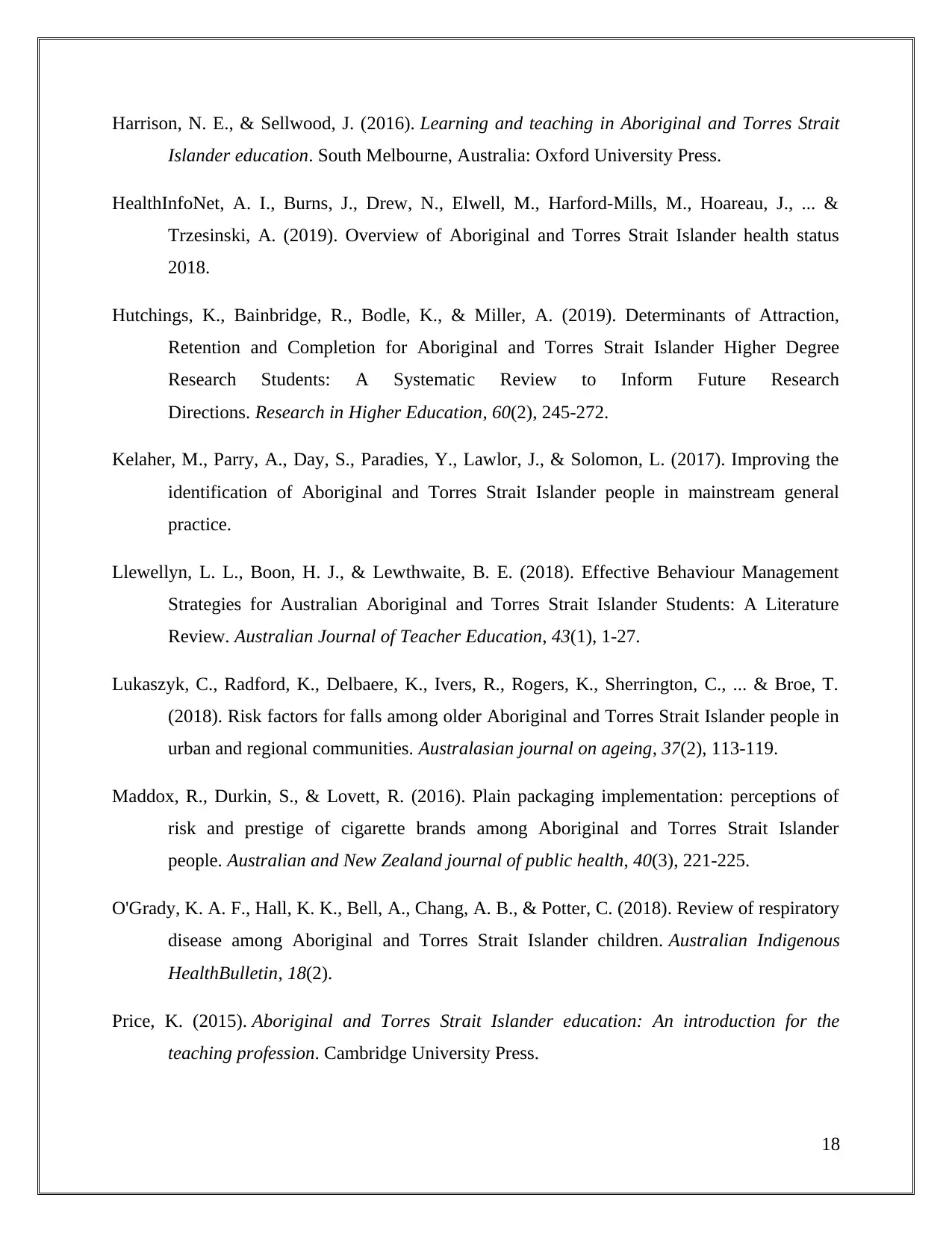
Harrison, N. E., & Sellwood, J. (2016). Learning and teaching in Aboriginal and Torres Strait
Islander education. South Melbourne, Australia: Oxford University Press.
HealthInfoNet, A. I., Burns, J., Drew, N., Elwell, M., Harford-Mills, M., Hoareau, J., ... &
Trzesinski, A. (2019). Overview of Aboriginal and Torres Strait Islander health status
2018.
Hutchings, K., Bainbridge, R., Bodle, K., & Miller, A. (2019). Determinants of Attraction,
Retention and Completion for Aboriginal and Torres Strait Islander Higher Degree
Research Students: A Systematic Review to Inform Future Research
Directions. Research in Higher Education, 60(2), 245-272.
Kelaher, M., Parry, A., Day, S., Paradies, Y., Lawlor, J., & Solomon, L. (2017). Improving the
identification of Aboriginal and Torres Strait Islander people in mainstream general
practice.
Llewellyn, L. L., Boon, H. J., & Lewthwaite, B. E. (2018). Effective Behaviour Management
Strategies for Australian Aboriginal and Torres Strait Islander Students: A Literature
Review. Australian Journal of Teacher Education, 43(1), 1-27.
Lukaszyk, C., Radford, K., Delbaere, K., Ivers, R., Rogers, K., Sherrington, C., ... & Broe, T.
(2018). Risk factors for falls among older Aboriginal and Torres Strait Islander people in
urban and regional communities. Australasian journal on ageing, 37(2), 113-119.
Maddox, R., Durkin, S., & Lovett, R. (2016). Plain packaging implementation: perceptions of
risk and prestige of cigarette brands among Aboriginal and Torres Strait Islander
people. Australian and New Zealand journal of public health, 40(3), 221-225.
O'Grady, K. A. F., Hall, K. K., Bell, A., Chang, A. B., & Potter, C. (2018). Review of respiratory
disease among Aboriginal and Torres Strait Islander children. Australian Indigenous
HealthBulletin, 18(2).
Price, K. (2015). Aboriginal and Torres Strait Islander education: An introduction for the
teaching profession. Cambridge University Press.
18
Islander education. South Melbourne, Australia: Oxford University Press.
HealthInfoNet, A. I., Burns, J., Drew, N., Elwell, M., Harford-Mills, M., Hoareau, J., ... &
Trzesinski, A. (2019). Overview of Aboriginal and Torres Strait Islander health status
2018.
Hutchings, K., Bainbridge, R., Bodle, K., & Miller, A. (2019). Determinants of Attraction,
Retention and Completion for Aboriginal and Torres Strait Islander Higher Degree
Research Students: A Systematic Review to Inform Future Research
Directions. Research in Higher Education, 60(2), 245-272.
Kelaher, M., Parry, A., Day, S., Paradies, Y., Lawlor, J., & Solomon, L. (2017). Improving the
identification of Aboriginal and Torres Strait Islander people in mainstream general
practice.
Llewellyn, L. L., Boon, H. J., & Lewthwaite, B. E. (2018). Effective Behaviour Management
Strategies for Australian Aboriginal and Torres Strait Islander Students: A Literature
Review. Australian Journal of Teacher Education, 43(1), 1-27.
Lukaszyk, C., Radford, K., Delbaere, K., Ivers, R., Rogers, K., Sherrington, C., ... & Broe, T.
(2018). Risk factors for falls among older Aboriginal and Torres Strait Islander people in
urban and regional communities. Australasian journal on ageing, 37(2), 113-119.
Maddox, R., Durkin, S., & Lovett, R. (2016). Plain packaging implementation: perceptions of
risk and prestige of cigarette brands among Aboriginal and Torres Strait Islander
people. Australian and New Zealand journal of public health, 40(3), 221-225.
O'Grady, K. A. F., Hall, K. K., Bell, A., Chang, A. B., & Potter, C. (2018). Review of respiratory
disease among Aboriginal and Torres Strait Islander children. Australian Indigenous
HealthBulletin, 18(2).
Price, K. (2015). Aboriginal and Torres Strait Islander education: An introduction for the
teaching profession. Cambridge University Press.
18
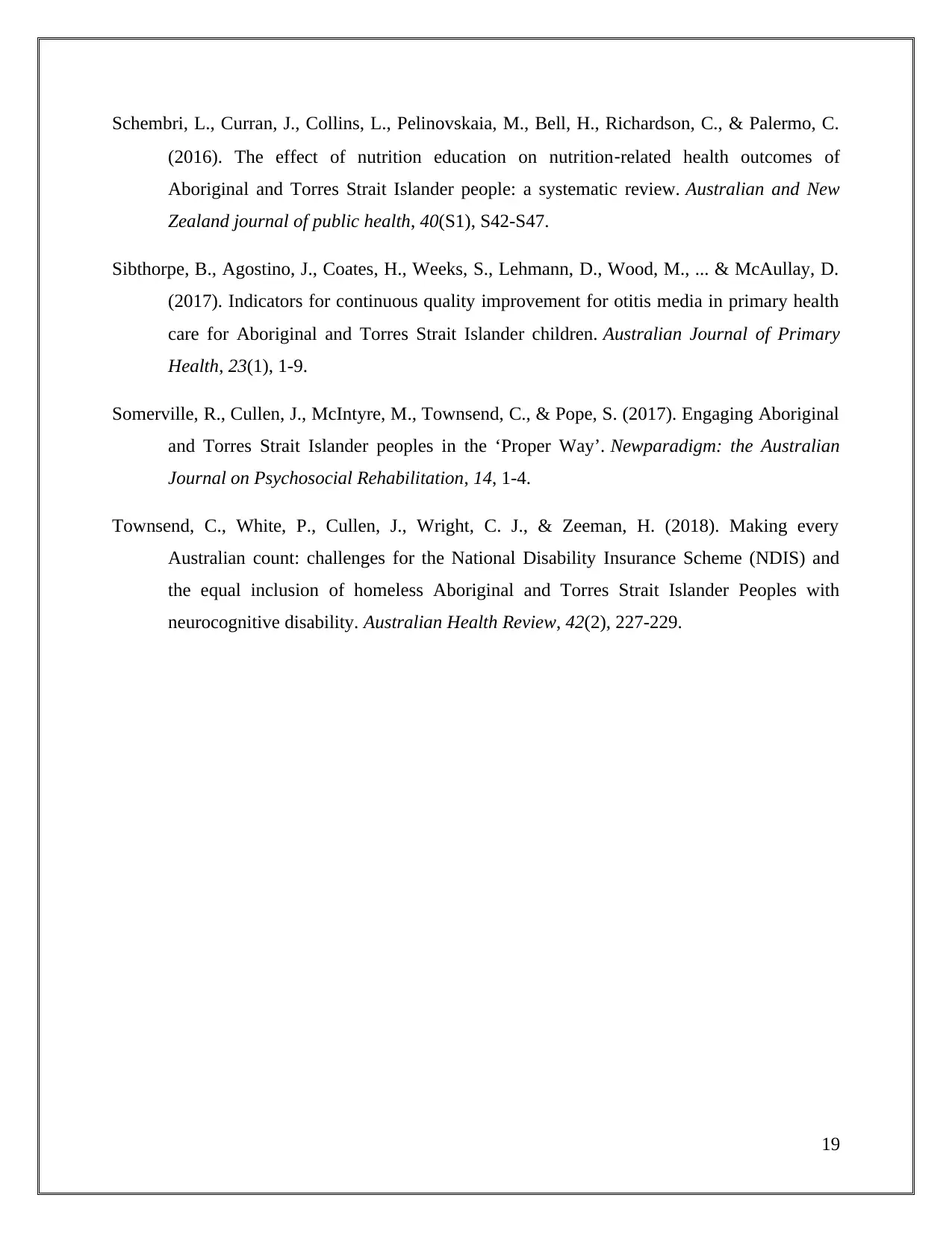
Schembri, L., Curran, J., Collins, L., Pelinovskaia, M., Bell, H., Richardson, C., & Palermo, C.
(2016). The effect of nutrition education on nutrition‐related health outcomes of
Aboriginal and Torres Strait Islander people: a systematic review. Australian and New
Zealand journal of public health, 40(S1), S42-S47.
Sibthorpe, B., Agostino, J., Coates, H., Weeks, S., Lehmann, D., Wood, M., ... & McAullay, D.
(2017). Indicators for continuous quality improvement for otitis media in primary health
care for Aboriginal and Torres Strait Islander children. Australian Journal of Primary
Health, 23(1), 1-9.
Somerville, R., Cullen, J., McIntyre, M., Townsend, C., & Pope, S. (2017). Engaging Aboriginal
and Torres Strait Islander peoples in the ‘Proper Way’. Newparadigm: the Australian
Journal on Psychosocial Rehabilitation, 14, 1-4.
Townsend, C., White, P., Cullen, J., Wright, C. J., & Zeeman, H. (2018). Making every
Australian count: challenges for the National Disability Insurance Scheme (NDIS) and
the equal inclusion of homeless Aboriginal and Torres Strait Islander Peoples with
neurocognitive disability. Australian Health Review, 42(2), 227-229.
19
(2016). The effect of nutrition education on nutrition‐related health outcomes of
Aboriginal and Torres Strait Islander people: a systematic review. Australian and New
Zealand journal of public health, 40(S1), S42-S47.
Sibthorpe, B., Agostino, J., Coates, H., Weeks, S., Lehmann, D., Wood, M., ... & McAullay, D.
(2017). Indicators for continuous quality improvement for otitis media in primary health
care for Aboriginal and Torres Strait Islander children. Australian Journal of Primary
Health, 23(1), 1-9.
Somerville, R., Cullen, J., McIntyre, M., Townsend, C., & Pope, S. (2017). Engaging Aboriginal
and Torres Strait Islander peoples in the ‘Proper Way’. Newparadigm: the Australian
Journal on Psychosocial Rehabilitation, 14, 1-4.
Townsend, C., White, P., Cullen, J., Wright, C. J., & Zeeman, H. (2018). Making every
Australian count: challenges for the National Disability Insurance Scheme (NDIS) and
the equal inclusion of homeless Aboriginal and Torres Strait Islander Peoples with
neurocognitive disability. Australian Health Review, 42(2), 227-229.
19
1 out of 19
Related Documents
Your All-in-One AI-Powered Toolkit for Academic Success.
+13062052269
info@desklib.com
Available 24*7 on WhatsApp / Email
![[object Object]](/_next/static/media/star-bottom.7253800d.svg)
Unlock your academic potential
© 2024 | Zucol Services PVT LTD | All rights reserved.




